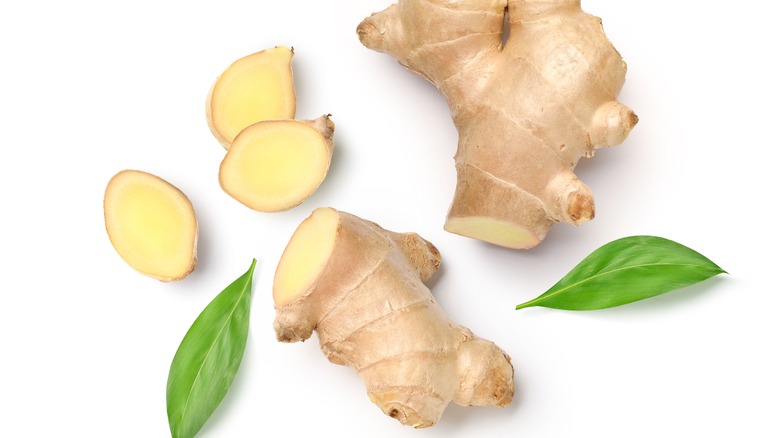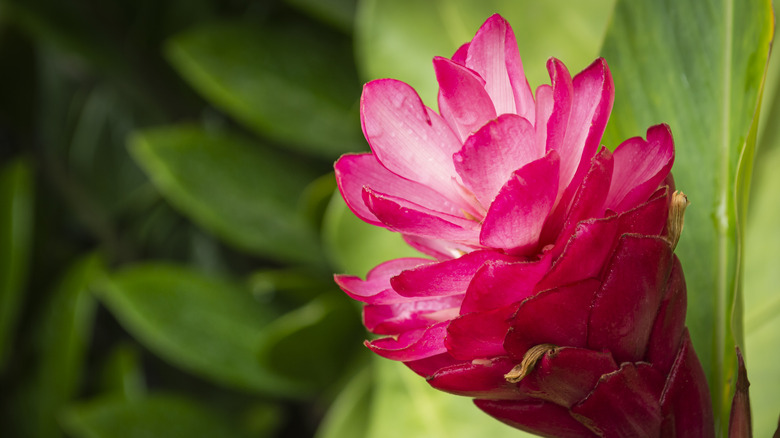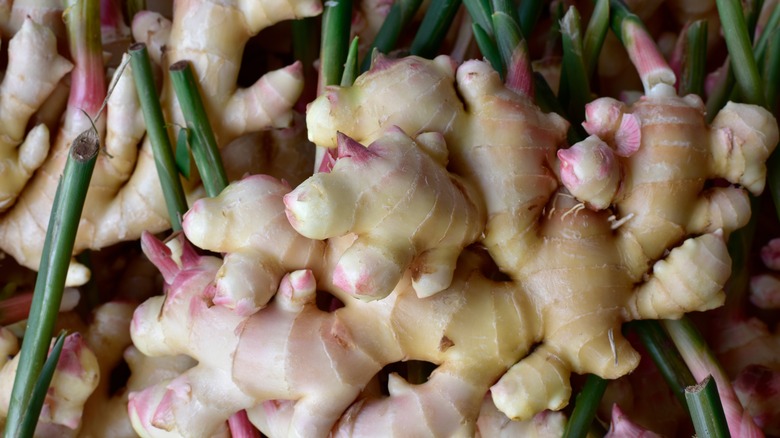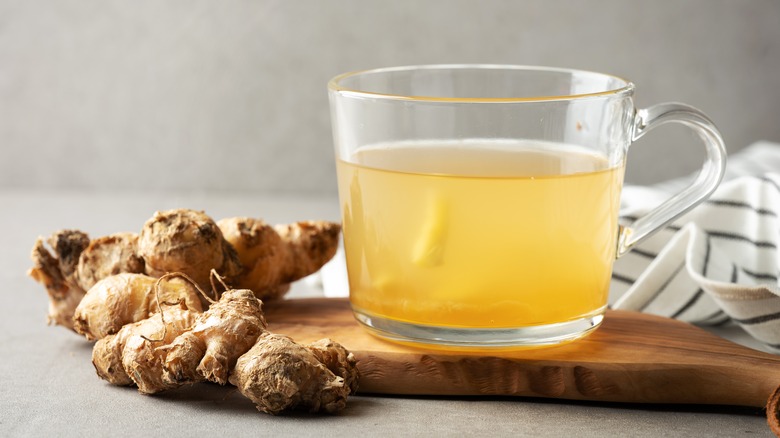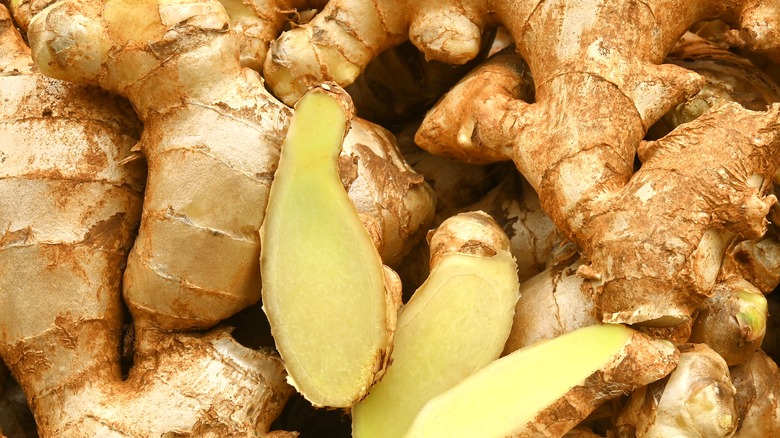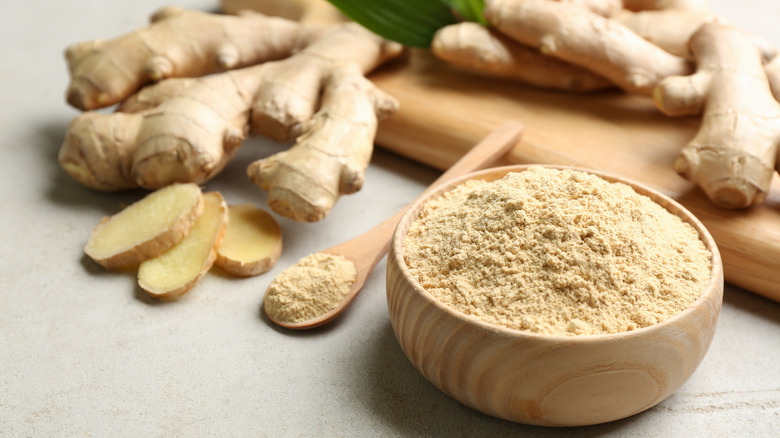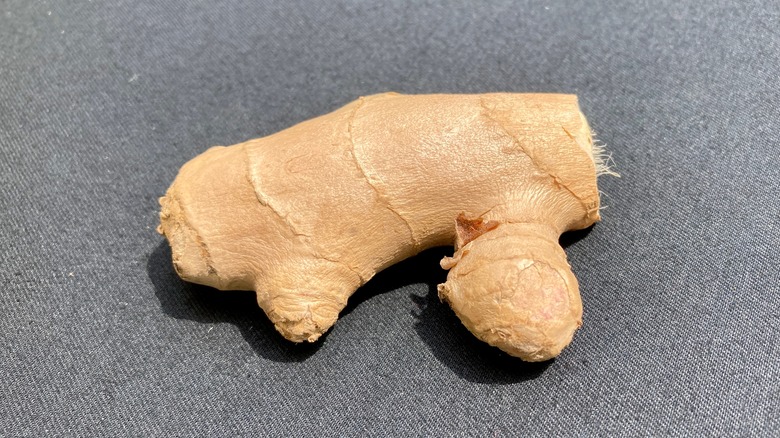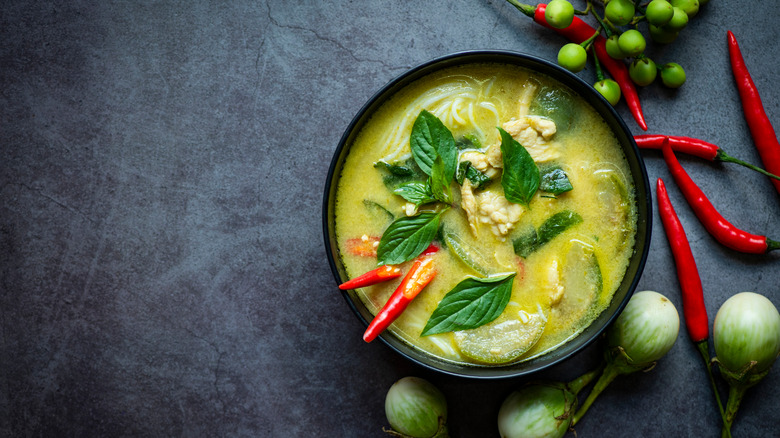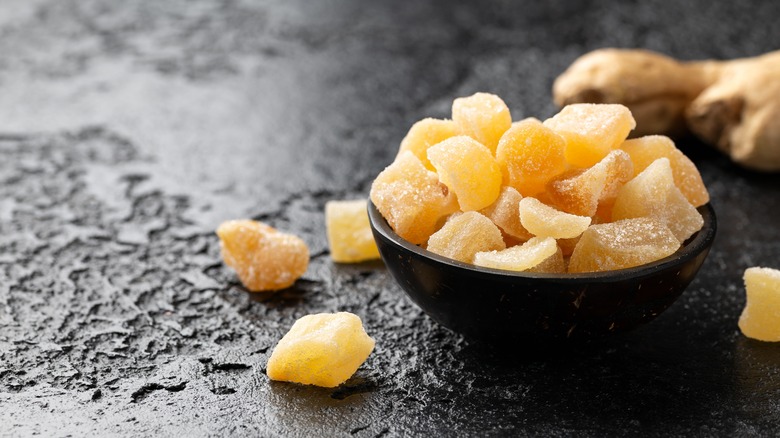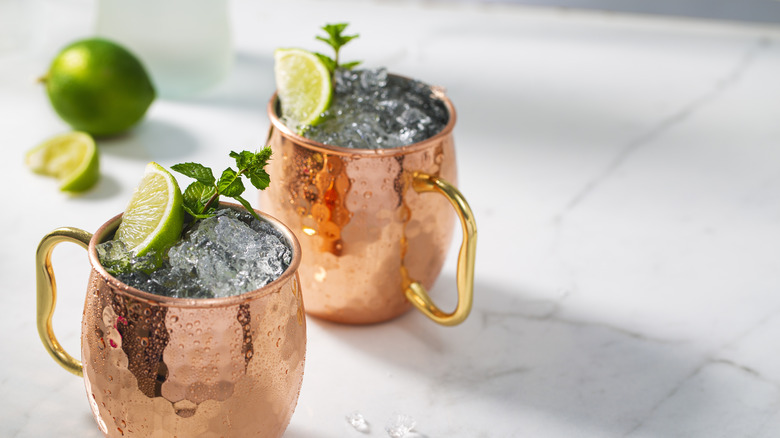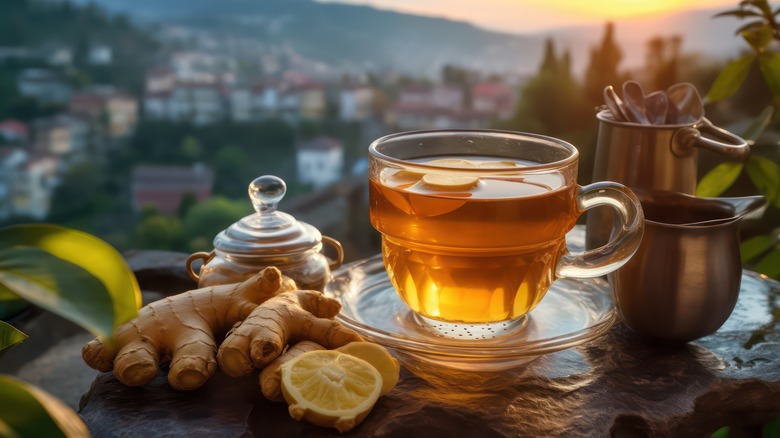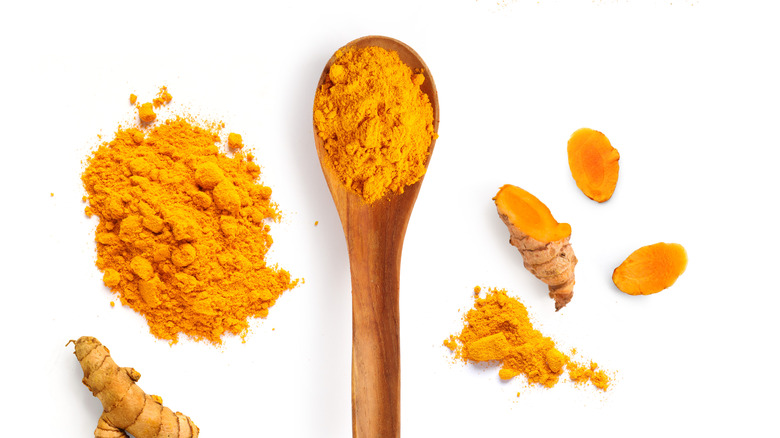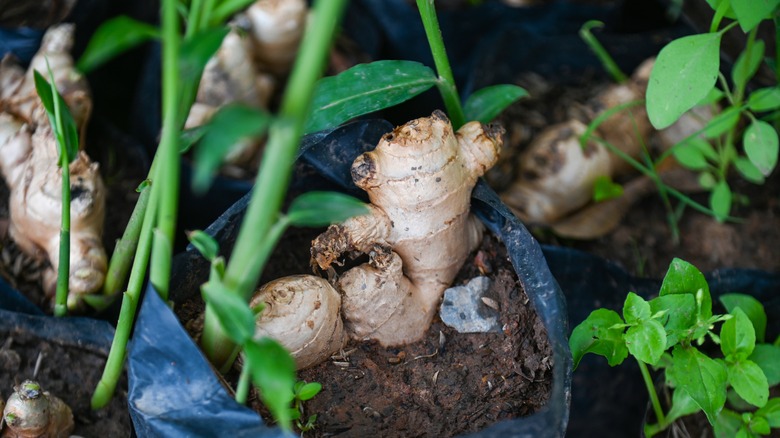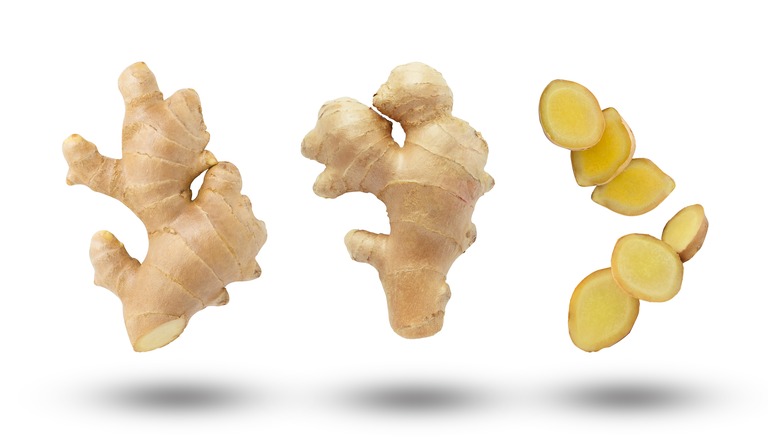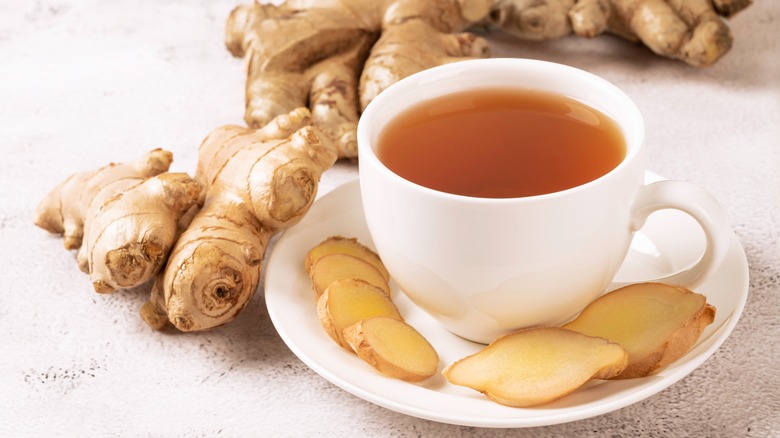The Complete Guide To Cooking With Ginger At Home
Ginger is a wonderful ingredient, full of health benefits and spicy, fragrant aromas. It lends itself to main dishes, snacks, pickling, desserts, and drinks — it's difficult to think of a more versatile spice on Earth. Used in ancient times from China to Europe, where a pound of it was at one point in the Middle Ages worth the price of a sheep, its role in human history goes back 5,000 years or more.
As if its delicious flavor isn't enough, ginger also helps food last longer due to its antimicrobial properties. It has been used in traditional cultures for thousands of years to manage the symptoms of a raft of different ailments, increase digestion, and calm the mind.
However, while many people enjoy this spice in cookies, kombucha, and curry from a store or restaurant, they don't know much about using this ingredient at home. If you, like many, occasionally throw some powdered ginger into a cookie recipe, then it's time to upgrade your understanding of how to choose it and use it. This complete guide will do just that, from general tips for cooking with ginger and novel ginger-rich recipes to guidance on how to properly prepare it. Get ready to be a ginger expert.
What is ginger and where does it come from?
Ginger (Zingiber officinale) is a perennial evergreen plant native to the tropics of Asia. It belongs to the Zingiberaceae family, which also includes turmeric, galangal, and cardamom, all of which frequently feature in dishes that also star ginger. Although ginger is technically a plant, when cooks or herbalists say "ginger," they are usually referencing the knobby, tan-to-brown, thick-skinned root (rhizome) of the plant. Inside the skin is a fibrous flesh that can be chopped, grated, or juiced for use in medicine and cooking.
Although its birthplace was most likely specific to Southeast Asia, ginger has been cultivated across the tropical regions of Asia and the Indian Subcontinent for so long that no one is really sure. Other sources say China, and its 5,000-year presence in traditional Chinese medicine (with the first written reference in 500 C.E.) makes it very hard to say.
What we do know is that the name ginger (and its genus name, Zingiber) goes back to the Greek word "zingiberis," which in turn stems from Sanskrit's "singabera." Other sources credit the Sanskrit word as "srngaveram," which means horn root.
A brief history of ginger
Although its use is as popular in modern cuisines as that of any other spice, ginger's roots (lol) go way back. Although we know it was first cultivated around 5,000 years ago, it was likely used medicinally and in cooking for longer than that ... as is the way of traditional herbs. It has been cultivated for so long, in fact, that it no longer grows in the wild, making it even harder to pinpoint where it originated.
In later antiquity, ginger became an important part of the spice trade, making its way to Ancient Greece and Rome from India. Indeed, Romans had a deep love of pickled ginger ... and who can blame them? Both ancient Greeks and medieval Europeans used ginger in bread to aid in digestion. After the fall of the Roman Empire, Arabic traders controlled the flow of ginger to the West, where it was beloved for sweets.
Ginger was later grown in the Caribbean, becoming a global spice that entered the modern age in the context of many different culinary traditions. Today, it is probably best known in Western culture for its role in gingerbread, a dish that was influenced both by ginger's availability and that of sugar, also produced in Caribbean colonies.
Ginger flavor
In general, the taste of ginger is fresh, sharp, spicy, and warm. A variety of compounds are responsible for this flavor profile, including zingiberene (about 30% of the root's oil content), ß-sesquiphelandrene, and ar-curucumene. Other compounds include vanillin, safranal, thymol, cinnamaldehyde ... and many other difficult-to-pronounce science words. However, the main ingredient that makes ginger sharp and hot is gingerol, related to capsaicin and piperine, which respectively make hot peppers and black pepper spicy.
Not all ginger is created equally, however. Among the many varieties of culinary ginger, for instance, are the shell and butterfly types. You can also get different flavors from using baby ginger, while eating older roots is not dissimilar from biting into a hot pepper. For that reason, many people choose between young and mature ginger depending on the recipe: young for lightly spiced recipes and tea, old for soups, stews, and curries. In the latter, it brings a woodsy flavor as well as the characteristic zing.
How to choose the best ginger
If you want the best results from your ginger recipes, you need to choose nice specimens at the grocery store, as with any other type of produce. Look for ginger that has an evenly colored, firm peel. If the ginger has dry spots or mushy places, or it is shriveled, give it a pass. Where possible, always choose a whole ginger root, with no pieces snapped off. Each time a knob gets removed, it provides an opening through which moisture can evaporate, drying out your root.
Note that it's okay if the skin has a greenish tinge to it; unlike potatoes, that doesn't indicate the development of toxic compounds. The color may come from the type of ginger or from being stored in a cold location, and either way is not a concern. The main thing to concern yourself with is not the color of skin, but rather the whole, firm flesh. Ideally, you want skin you can remove easily. The best way to determine this is to try scraping a small piece of skin away with a fingernail. If you can, you're good to go.
Fresh versus dried ginger
Ginger is typically available in one of two ways: fresh or dried. The fresh ingredient may come from the store as a root covered in skin or pre-peeled, or chopped in a jar with liquid. Almost any medium-sized grocery store will have most or all of these versions. Dried varieties are usually powdered, and all grocery stores have ginger in spice jars, though you can also find ginger flakes online.
The debate about fresh versus dried herbs and spices rages unabated. Some say dried spices have a better flavor, others insist that fresh is the way to go. Some sources say ground ginger is warming, while fresh ginger is ... well, refreshing, good for drinks, smoothies, and lighter dishes. The one thing most people agree on is this: Fresh and dried ginger are different. You can't simply substitute one for the other without accounting for differences in potency and flavor. (See "Substitutes for ginger" for ratios on how to sub out fresh for dried, and vice versa.)
If you're concerned about the better version for health issues, opt for powdered ginger. The dried variety contains more concentrated nutrients, making it a more potent addition to soups, stews, and teas. However, if you just want to add some antioxidant goodness to your life, then fresh ginger is the way to go, with higher levels of cancer-fighting compounds.
How to prepare ginger for cooking
If you're looking at a ginger root and thinking, "Like, what? How is anyone supposed to get into that thing?" then you're not alone. Ginger is a little tricky to access, but once you know the deal, it's pretty simple.
First, you have to peel the ginger. One of the best ways to get the skin off is by peeling the root with a spoon instead of a knife. This works well for young and middle-aged ginger, though roots with really tough skin may require a knife or vegetable peeler. Even then, a spoon is handy for getting the last bits off without cutting away too much of the edible flesh. If the root is particularly gnarled, it's sometimes easier to remove some of the lobes first.
Once you have fresh, yellow, skinless root, you can further prep it in a variety of ways. Usually this depends on what your dish calls for. Because ginger is so firm, you can easily slice, julienne, or grate it. You can also roast ginger for more elevated and complex flavors.
The best uses for ginger in cooking
There are so many ways to use ginger in cooking that it's impossible to narrow them down effectively in one article. Ginger is wonderful as an addition to soups and stews, stir-fries, rice dishes, and curries. It is delicious as a condiment, especially when pickled or put in chutney. As an ingredient in glazes and marinades, it really shines in chicken and pork dishes. You can always make a delicious salad dressing using fresh or dried ginger as well, or simply toss minced ginger in with some spinach leaves or baby greens.
If you have never cooked with ginger, then familiarize yourself with this spice by making some fairly basic recipes to start. Roasted butternut squash soup is always a good one, since it uses cheap ingredients and you can make a pot big enough to feed your family for a week in only a few hours. Ginger chicken jook porridge is a little more creative, but easy enough that you can experiment without really leaving your comfort zone. You can also elevate bone broth and vegetable stock by adding ginger, where it will give a warming zing to your soups and stews.
A good bet for adventurous home cooks is to simply google "[your favorite recipe] ginger." This will pull up dishes you already know how to cook in a general sense, with the addition of ginger to spice things up, both literally and figuratively.
Ginger in desserts
From classic gingerbread men to the houses kids decorate at Christmastime in Western culture, to mango ginger clafoutis in Indian cooking, to ginger cookies with ras el hanout (a delicious Arabic spice mixture), ginger has its fingers in everything sweet. It's great in pound cake, pudding, and ice cream too. Honestly, what can't a person do with ginger and sugar? (Fun fact: sugarcane is from roughly the same birthplace as ginger, so they've always been a match made in heaven.)
If you're ready to expand beyond traditional gingerbread, try making molasses cookies with ginger or candied ginger shortbread. Add it to lemon bars for a zesty kick in the summertime, or use ginger simple syrup (see the easy recipe discussed in "Happy hour, ginger style") to flavor your ice creams, gelatos, and bombes.
Ginger also works well in warm recipes, such as apple pie or bundt cake. Make like New Zealanders and put it in slice, which is just a quirky way of saying "bars." You can even put it in your granola to top yogurt or crunch by the mouthful while sitting at your desk and dreaming of faraway places, preferably the ones where ginger grows.
Happy hour, ginger style
Ginger is a fun addition to cocktails and mocktails. Whether you're an NA booze fan or a regular booze fan, ginger's spice and tang can level up drinks for your next party, lazy afternoon, or camping trip. You can work the ginger into your beverages in a few different ways, including making simple syrup, using ginger liqueur, or even muddling it.
To muddle ginger, simply grate or slice it thinly, then mash it up with the back of a spoon before adding it to your drink. Using a ginger liqueur skips this step and enables you to add great flavor without extra effort. Plus, it's only about $20 for 12 ounces. If you like, you can make your own simple syrup by combining a cup each of sugar and water with ¾ cup of freshly sliced ginger. Bring to a boil, then simmer for 15 minutes before removing from heat to cool.
Some fun drink ideas include sparkling grapefruit and ginger cocktails, rhubarb-ginger coolers, Southern Baptists (with rye whiskey and ginger syrup), and mango shandies. Moscow mules are another classic ginger drink. Whatever approach you take, make sure you choose a nice, flavorful alcohol that can counterbalance the fire of ginger, such as whiskey or Prosecco.
Ginger's many health benefits
In addition to tasting delicious and adding welcome heat to many dishes, ginger is also fantastic for your health. According to research in the journal Cephalalgia, ginger has been shown to offer statistically significant pain relief in migraine studies. Moreover, it can help with GI issues, such as nausea, bloating, gas, and the unpleasant side effects of pregnancy and chemotherapy. In other words, ginger is a great health food for anyone ... because let's be honest, who hasn't had GI issues in their life?
Even more impressively, ginger may help prevent and even fight cancer, as it kills cancer cells, according to research in the journal Food Science & Nutrition. More accurately, ginger appears to induce apoptosis (controlled cell death) in cancerous cells, causing them to die off on their own. While the evidence of this so far requires more research, it is a promising step forward in the global fight against cancer.
Moreover, ginger can assist in ameliorating a variety of other disorders. For instance, it may aid in fighting diseases such as rubella and tuberculosis. It can help with inflammatory and autoimmune diseases, growth disorders, hypertension, and more. Other potential benefits include assisting in the fight against bacterial infections, vomiting, and hypercholesterolemia (a fancy word for high cholesterol).
Substitutes for ginger
The best substitute for ginger is another kind of ginger. If your recipe calls for dried and you have fresh, or vice versa, start there. Baking? Candied or crystallized ginger is a good bet. However, you can't substitute dried herbs or spices for fresh willy-nilly. To substitute fresh ginger for powdered ginger, use the rough translation of ¼ teaspoon powdered ginger for each teaspoon of fresh and grated ginger.
If you don't have ginger of any kind, you're going to have to get more creative, as there really isn't much that simulates this spice very effectively. In a pinch, though, you can try galangal, another root that has less heat and more citrus flavor to it.
Turmeric is another option. While brighter orange in color and with a smokier, earthier flavor profile, it can work as a substitute in soups, stews, curries, and other savory dishes. Other common baking spices, such as nutmeg, mace, and allspice, can do the trick as well if all you're looking for is some heat.
How to grow ginger
Interested in growing ginger in your backyard? The good news is, you can. Specifically, you can grow it outdoors year-round if you live in USDA Zones 9 and above. Never fear: If you live in Zones 8b and below, you can still grow it. You will simply have to treat ginger like an annual, either bringing it indoors to overwinter or waving a heartfelt goodbye and planting a new one in spring. Better yet, put it in your greenhouse or conservatory, where it will stay happy forever. If you prefer, you can even plant it in the ground in summer, then dig it up and containerize it come winter.
You can start your ginger in one of a few ways. If nearby nurseries sell it, that might be the easiest approach. However, you can also buy a root from the store and plant it shallowly in compost-rich soil. Then make sure it stays somewhere warm and sunny, either out in the yard, in a container inside, or in a greenhouse (where it can be either in a container or in the ground).
How to store ginger for maximum flavor and nutritional value
The best way to keep ginger fresh is to avoid peeling it for as long as possible. Ginger will stay good for several days in its unpeeled form on the counter, and for up to a month in the fridge without peeling. Once you've peeled it, you must put it in the refrigerator carefully covered in order to keep it fresh, where it will last between 2 and 3 weeks.
Pickling can extend the lifetime of ginger significantly, with some sources claiming pickled foods last indefinitely in unopened jars (which has been this writer's experience). Once you open it, or if you made it yourself, use pickled ginger within 6 months.
When storing spices for the longest lasting flavor, make sure to keep powdered varieties in airtight jars in a cool, dry place. Although you do not have to keep powdered ginger in the dark, you should avoid direct sunlight, which can break down spices. Make sure to hang your spice rack either inside a closet or pantry, or in a corner of the kitchen that doesn't get direct light.
Nutritional information
Raw ginger contains very few calories, about 20 in ¼ cup of slices. If you can eat that many raw slices of ginger, more power to you. Most people, however, stick to ginger as a seasoning. When speaking about the nutritional information of ginger, therefore, the traditional concerns (fat, sugar, calories) don't matter. Rather, it is helpful to know ginger's nutritional profile as well as possible side effects of taking too much of it.
As for nutrients, you'll get a helpful dose of potassium, as well as small amounts of magnesium, phosphorous, folate, and choline, and trace amounts of vitamin C, among other vitamins and minerals. As healthful as it is, it's important to watch out for overdoses of ginger. While it can't kill you, it can cause diarrhea, heartburn, stomachache, and irritation to the mouth. If pregnant, you should talk to your primary care provider before using large doses of ginger medicinally.
